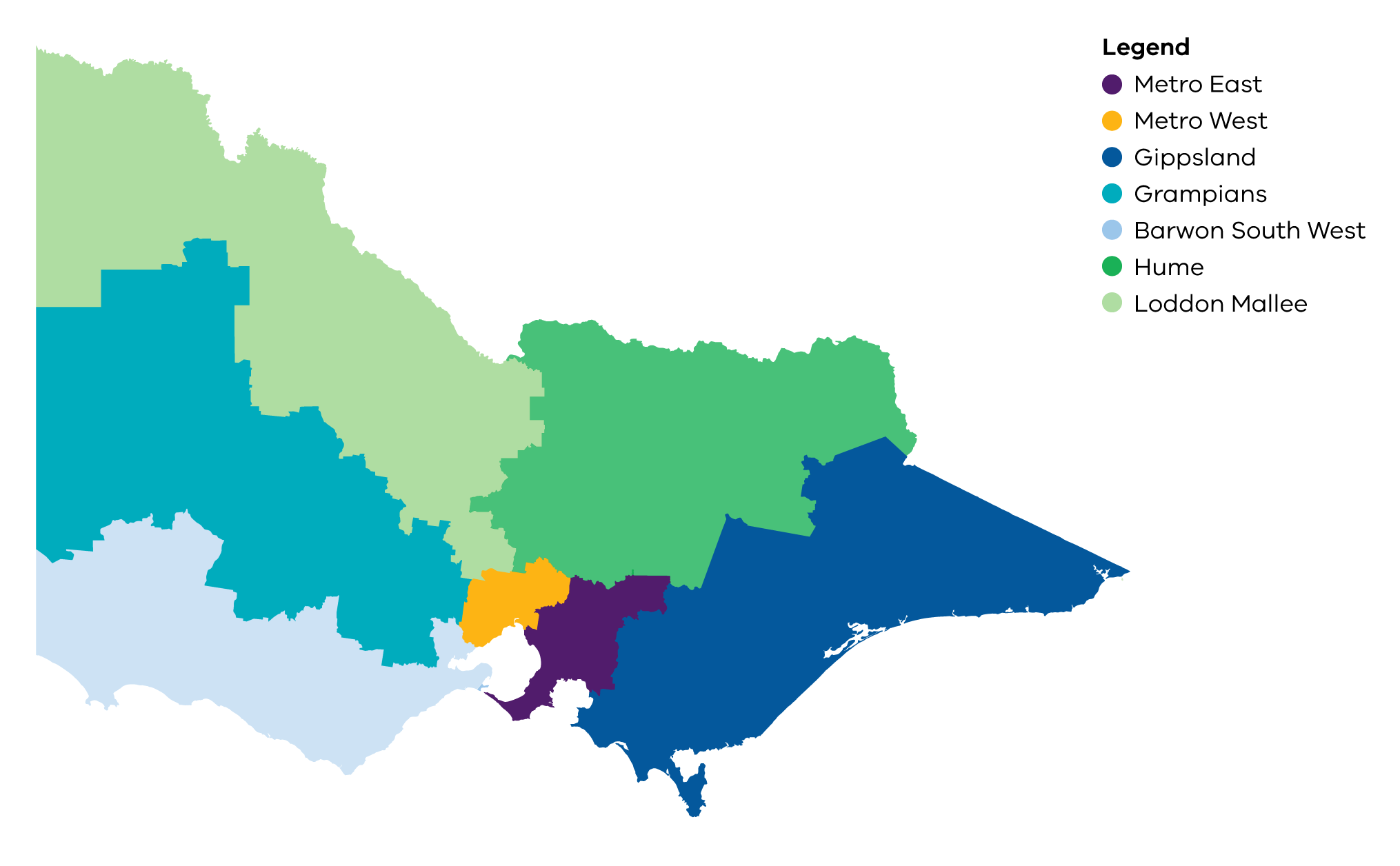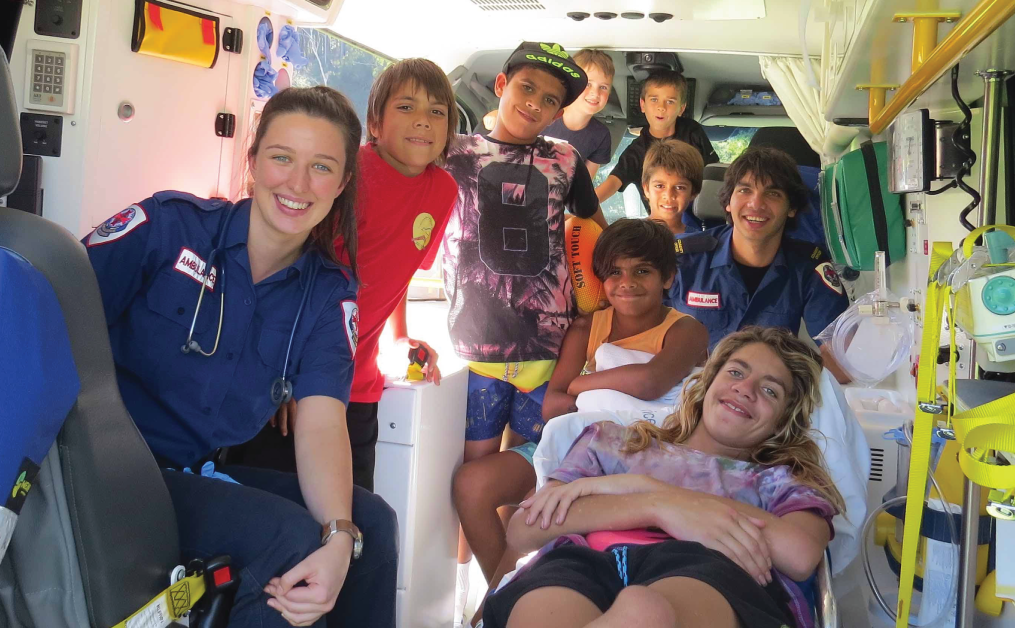Overall experience
In 2018–19, 5,474 Victorians completed a survey about how they experienced ambulance care.
The survey asks patients to rate their overall experience of using an ambulance service.
A patient’s experience is considered positive if they rate their care as either ‘good’ or ‘very good’ when they are asked:
‘Overall, how would you rate the care and/or treatment and/or advice and/or transport you received from the ambulance service?’
A higher percentage shows more patients had positive overall experiences.
During 2018–19, almost all patients (97%) said they had a positive overall experience of care from an ambulance service. This is consistent with the findings from 2017–18.
At the time of the surveys, Ambulance Victoria’s services were divided into seven regions across the state. There were two metropolitan Melbourne regions (Metro East and Metro West) and five regional and rural regions (Barwon South West, Gippsland, Grampians, Hume and Loddon Mallee). Figure 1 shows the seven Ambulance Victoria regions.

The results were mostly consistent across the state:
- Within metropolitan Melbourne, results ranged from 98% in Metro East to 96% in Metro West.
- Within regional and rural Victoria, results ranged from 98% in Gippsland and Grampians to 95% in Loddon Mallee.
Table 1 summarises these results.
Table 1: Percentage of adult ambulance patients whose overall experiences of care were positive in 2018–19
|
Ambulance regions |
% positive rating |
Change from last year |
|---|---|---|
| Victoria (statewide average) | 97 | 0 |
|
Metro |
||
| Metro East | 98 | +1 |
| Metro West | 96 | -1 |
|
Regional and rural |
||
| Gippsland | 98 | -1 |
| Grampians | 98 | -1 |
| Barwon South West | 97 | +1 |
| Hume | 96 | -1 |
| Loddon Mallee | 95 | -2 |
Notes: Number of survey responses for 2018–19: 5,474; response rate 29%. Number of survey responses for 2017–18: 5,233; response rate 29%.
Respondents include patients aged 16 and over who called Triple Zero and received emergency ambulance services. Recipients of air ambulance services are not included in the survey cohort.
Source: Victorian Agency for Health Information analysis of the Victorian Healthcare Experience Survey dataset, 2017–18 and 2018–19. Data supplied by Ipsos Social Research Institute. Data extracted 8 October 2019.
Ambulance Victoria is working to improve Aboriginal Victorians’ experiences of care. Read about the improvement story below.
Overall experience of groups of Victorians in 2018–19:
- Fewer Aboriginal Victorians (78%) said they had positive overall experiences of care compared with non-Aboriginal Victorians (96%).
- Men, women and people who identified as another gender had equally; positive experiences of care.
- Slightly more Victorians aged 50 and over had positive experiences of care (96%) than those under 50 years of age (94%).
Note: These results are statistically significant.
Factors that influence patients’ overall ambulance experience
Our analysis of the data shows the things that influence patients’ overall experience of ambulance services are:
- having the right care and advice for your situation
- having confidence and trust in the paramedics
- being treated with respect and dignity
- feeling listened to and understood.
Tables 2 and 3 summarise these results.
Table 2: Percentage of adult ambulance patients whose overall experiences of care were positive in 2017–18 and 2018–19
| Overall rating of care | Percentage (%) positive rating | Change | |
| 2018–19 | 2017–18 | ||
| Rating the overall care you received from the ambulance service as good or very good | 97 | 97 | 0 |
Table 3: What influenced patients’ overall care experience in 2018–19
| Key aspects of care | Percentage (%) positive rating | Change | |
| 2018–19 | 2017–18 | ||
| Feeling that the ambulance service definitely provided you with the right care or advice, given your medical circumstances | 91 | 92 | -1 |
| Definitely having confidence and trust in the paramedics | 96 | 96 | 0 |
| Definitely being treated with respect and dignity by the paramedics | 97 | 97 | 0 |
| Definitely feeling listened to and understood by the paramedics | 93 | 94 | -1 |
Notes: Number of survey responses for 2018–19: 5,474; response rate 29%. Number of survey responses for 2017–18: 5,233; response rate 29%.
Respondents include patients aged 16 and over who called Triple Zero and received emergency ambulance services. Recipients of air ambulance services are not included in the survey cohort.
Source: Victorian Agency for Health Information analysis of the Victorian Healthcare Experience Survey dataset, 2017–18 and 2018–19. Data supplied by Ipsos Social Research Institute. Data extracted 8 October 2019.
Improvement story
Best Care – improving Aboriginal people’s experiences of ambulance services
Ambulance Victoria know that they need to do better to meet their patient care commitment to Aboriginal people and to address their specific health needs. The Best Care program is part of the steps Ambulance Victoria are taking to do this. Ambulance Victoria now have a clear roadmap to improving their capability to provide safe, accessible and culturally appropriate care. Their Cultural Safety and Equity Action Plan is led and championed by CEO Tony Walker.
‘We are committed to continuing our focus on improving cultural safety and developing our Reconciliation Action Plan in 2020 to create new, and strengthen existing connections, with Aboriginal and Torres Strait Islander people and communities across the state.’
– Tony Walker, CEO Ambulance Victoria
During 2019, Ambulance Victoria have prioritised cultural safety across the organisation with a variety of communication forums, ensured all staff completed mandatory cultural awareness training, and incorporated cultural safety topics into both leadership and clinical development.

Ambulance Victoria have also begun working with the community to develop a Statement of Commitment to Reconciliation and are planning to begin development of the organisation’s first Reconciliation Action Plan this year.
Ambulance Victoria have established a working group with representatives from diverse Aboriginal community groups. The working group is focused on listening to the needs of community members, with the aim to integrate sustainable services that contribute to improving outcomes of physical, emotional, and social health and wellbeing. At the core of this work is a commitment to self-determination, promoting respect and resilience.
Within local indigenous communities across Victoria, Ambulance Victoria paramedics are working to better understand localised health needs and appropriate responses. This work will build relationships and services that will ensure equity of access to ambulance care for Aboriginal people.
A special working party will ensure that all the improvements Ambulance Victoria have committed to over the next three years are completed. They are reporting this progress to their Board and to the Department of Health and Human Services.




